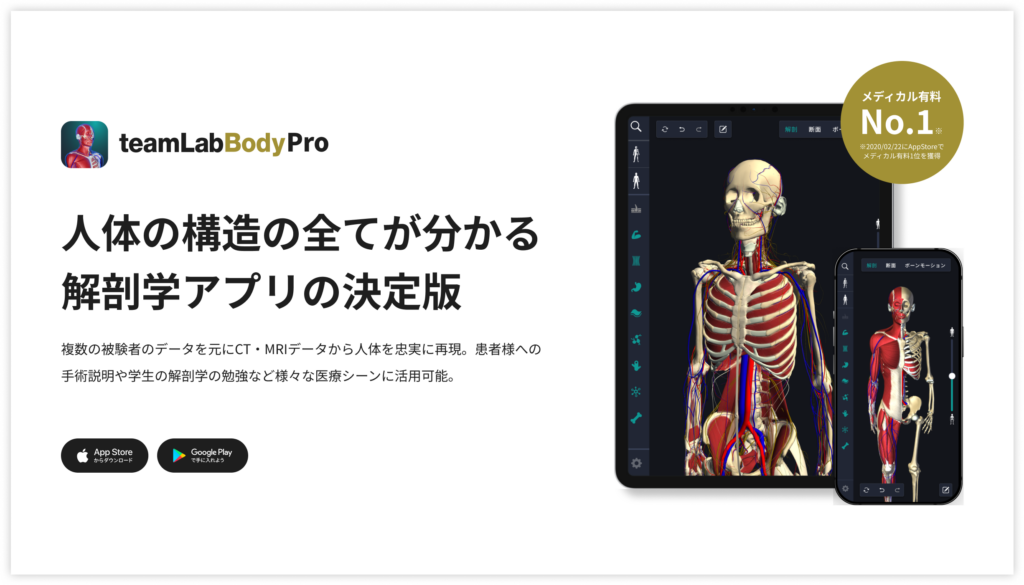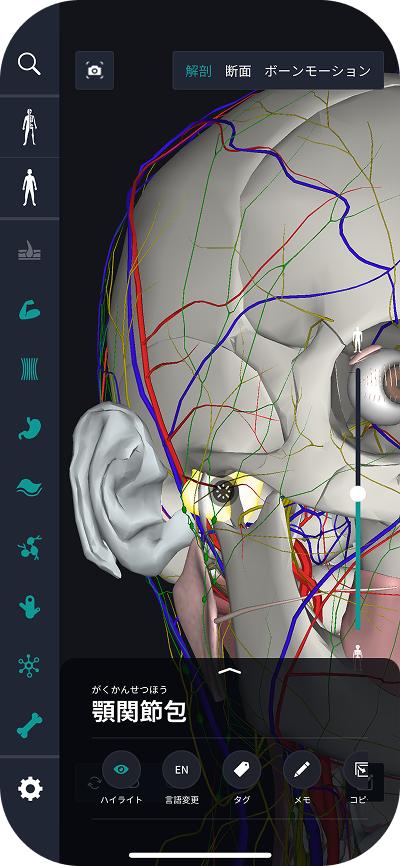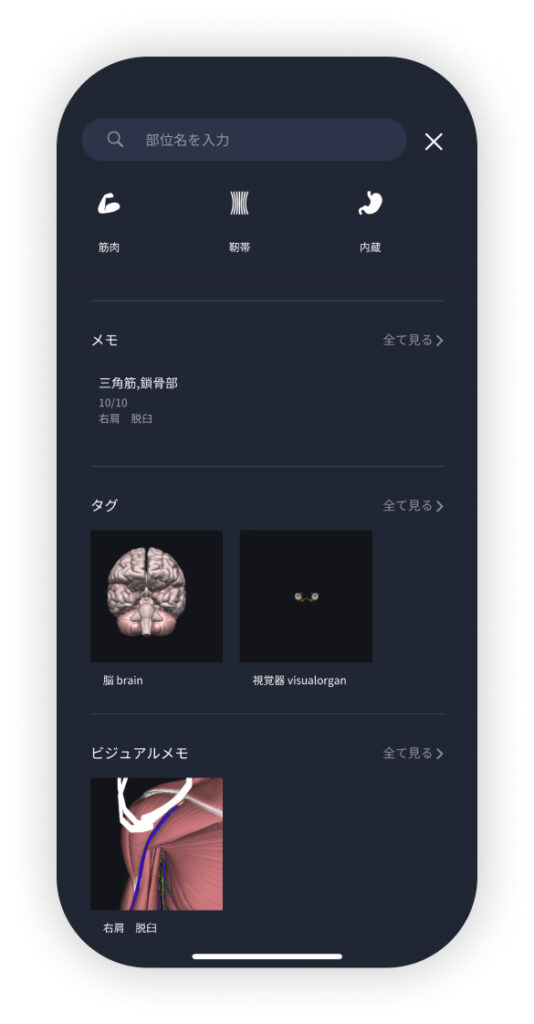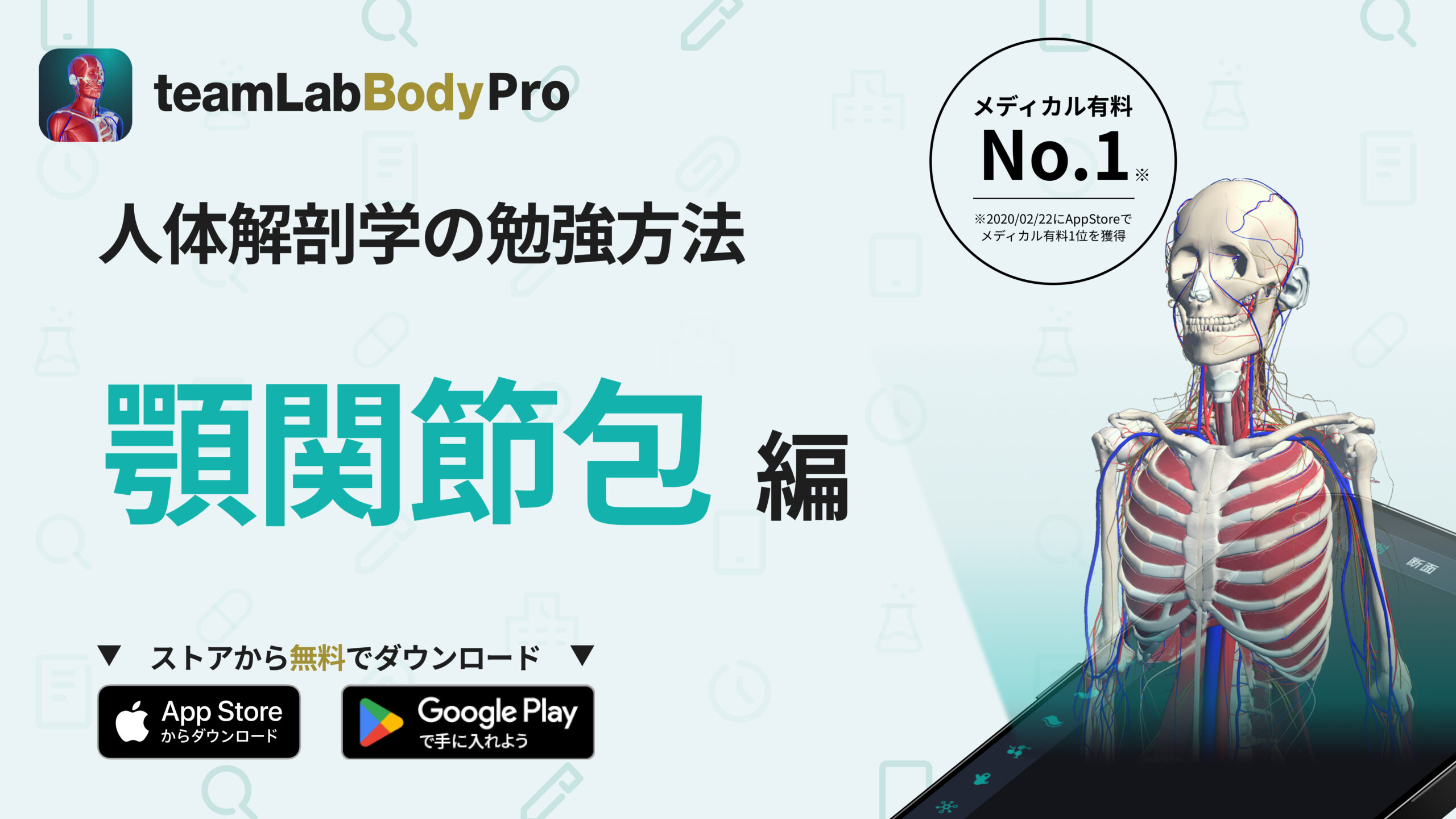beginning
In this article, I will explain effective study methods, starting with knowledge of specialized parts in human anatomy.
In human anatomy, it is necessary not only to memorize the names of various organs, muscles, and bones, but also to remember where they are located in the body. Therefore, it is necessary to learn as efficiently as possible.
I hope you will deepen your understanding even a little by reading this article and using the app.
Now, I'll explain the details about the “temporomandibular capsule” and how to study human anatomy.
teamLab Body Pro Free Download
A 3D anatomy app that shows all the structures of the human body
Download teamLab Body Pro here!

What is the temporomandibular capsule?
The anatomy application allows you to view a selection of anatomy 3D models. In this model, there are various observation methods such as surfaces, cross-sections, and nervous systems. This time, I'll explain using an anatomy application.
About temporomandibular capsule

The temporomandibular joint capsule (temporomandibular joint capsule) is a connective tissue structure that surrounds the temporal joint connecting the mandible (mandible) and temporal bone (temporal bone). This joint capsule plays a role in maintaining the stability of the temporomandibular joint and supports smooth joint movement. The temporomandibular joint plays a very important role when eating and talking, so understanding its function is essential.
The temporomandibular capsule is a membrane of connective tissue that surrounds the joint and holds synovial fluid (joint fluid) within the joint and reduces friction due to joint movement. Furthermore, it also plays a role in limiting the range of motion of the jaw joint, and prevents joint damage by preventing excessive or inappropriate movements. The temporomandibular capsule is an important structure that helps the normal movement of the jaw by cooperating with the ligaments connecting the maxilla and mandible.
The temporomandibular capsule also plays a role in supporting cartilage (joint disc) within the temporomandibular joint, and supports movement and sliding of the joint disc. This disc is an essential element for smooth movement of the temporomandibular joint, and by cooperating with the temporomandibular capsule, it enables efficient movement during chewing and speech.
Study points
Anatomical understanding: accurately capture structure and positional relationships
The temporomandibular capsule plays an important role in supporting the range of motion and movement of the temporomandibular joint. First, it is basic to understand the anatomy of the temporomandibular joint, and remember which part of the temporomandibular joint capsule is located, and which bones and ligaments are involved. The temporomandibular capsule is a connective tissue membrane that surrounds the inside and outside of the joint, so it is important to have a deep understanding of its morphology and role.
Also, it is essential to know how the temporomandibular capsule works with the joint disc to support movement. Understanding is deepened by visually checking joint movements and structures using 3D anatomy apps and models.
Functional understanding: learning in relation to movement
Since the temporomandibular joint performs important movements related to eating, speech, etc., the role of the temporomandibular joint capsule is also very important. When learning, you can understand how the temporomandibular capsule restricts joint movement and makes it smooth by actually experiencing the movement of opening and closing the mouth.
Also, learning how the temporomandibular capsule cooperates with cartilage and ligaments within the joint to support movement will lead to an understanding of movement.
Practical application: deepening from clinical relationships
The temporomandibular capsule is related to clinical diseases such as temporomandibular joint disease and temporomandibular arthritis. These diseases can be caused by abnormalities or damage to the temporomandibular capsule, and pain and discomfort occur when joint movement is restricted. Understanding the anatomy and function of the temporomandibular capsule is important for clinical diagnosis and treatment. In particular, patients with temporomandibular joint disease are required to evaluate inflammation or damage to the temporomandibular joint capsule and select appropriate treatment.
Treatment may include physical therapy, medication, and surgical interventions, and properly understanding the role of the temporomandibular capsule is useful for treatment.
How to study human anatomy
I will explain specific study methods using human anatomy applications.
Check your past learning history and practice repeatedly
Here are the steps to check your anatomy learning history and practice iteratively effectively.
1. Check your learning history in the app
Reviewing your learning history with the application is an important step in effectively advancing anatomy learning. First, launch the app and go to the learning history section from the main menu. Many anatomy apps are designed to show your progress in the form of graphs and lists, so you can visually check which parts you've learned about and how much time you've spent.
By using this data, you can understand which areas you have strengths in and where you need to spend more time and effort. We also recommend using a dedicated tag or notebook function to mark areas you are particularly weak at or where you need to relearn. Regularly checking your learning history and looking back on past learning content will lead to efficient review and deepening understanding.
2.Make a plan for iterative learning
Making an efficient repetitive learning plan based on learning history is extremely effective in promoting knowledge retention. First, identify weak points and areas where you need to relearn. Next, arrange these study items into a weekly or monthly calendar and create a specific study schedule. By proceeding in a planned manner, you can learn each part evenly and avoid packing in a large amount of information at once.
Using a task management app or digital calendar to set study reminders is effective. Also, it's important to have the flexibility to regularly review progress and revise plans as needed. By having goals and proceeding with your studies in a planned manner, you can efficiently acquire anatomical knowledge.
3.Use 3D features to learn visually
By utilizing the 3D function, learning anatomy is easier to understand visually. The 3D model shows the structure of the human body three-dimensionally, and each part can be observed in detail. This makes it possible to intuitively grasp positional relationships between deep muscles and organs that are difficult to capture in a planar view. For example, you can learn even the smallest details by rotating specific muscles and bones and zooming in and out.
Also, there are many apps that have the function of displaying cross-sectional views of each part using a 3D model, which is useful for deepening understanding of internal structures. This diversity of visual information helps with memory retention and improves immediate responsiveness in tests and practice situations. By utilizing the 3D function and learning visually, you can learn anatomy knowledge more deeply and efficiently.
Use the memo function concretely

Make notes so you don't forget the things and points you've noticed while studying. The memo function can be used for different purposes, such as inputting text, saving images, and writing memos. Tag your notes to make them easier to review later.
Test your learning regularly in the form of quizzes
Regularly testing what you've learned in a quiz format is a very effective way to anchor your anatomy knowledge. Quiz-style tests help you objectively grasp your level of understanding and areas you lack while repeating knowledge.
For example, by using a learning app to conduct quizzes every specific period, you can reconfirm what you've learned and strengthen your memory. There are a wide range of quiz formats, such as multiple choice questions, fill-in-the-blank questions, and short answer questions, and each helps understanding from a different angle and develops the ability to utilize various types of knowledge.
Get feedback
If possible, get feedback from other learners and experts. It helps you find your own gaps in understanding and areas for improvement. You can also keep yourself motivated to learn by regularly testing yourself. Feeling a sense of accomplishment and progress increases motivation for continuous learning.
summary
This time, I explained how to study about the “temporomandibular joint capsule” using an application!
Thank you for reading this far.
I would be happy if reading this article helped you learn about anatomy.
Learning is a long, never-ending journey, but I sincerely wish you all the best. Let's continue to study together and work hard for the national exam!
Please look forward to the next blog.
teamLab Body Pro Free Download
A 3D anatomy app that shows all the structures of the human body
Download teamLab Body Pro here!





